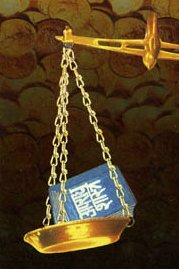Bhandagara, Bhaṇḍāgāra, Bhamdagara: 16 definitions
Introduction:
Bhandagara means something in Hinduism, Sanskrit, Buddhism, Pali, the history of ancient India, Marathi, Jainism, Prakrit. If you want to know the exact meaning, history, etymology or English translation of this term then check out the descriptions on this page. Add your comment or reference to a book if you want to contribute to this summary article.
In Hinduism
Arthashastra (politics and welfare)
Source: Shodhganga: Kakati Ganapatideva and his times (artha)Bhaṇḍāgāra (भण्डागार).—Another important office, in the administration was treasury. The treasury was incharge of bhaṇḍāri and treasury department, is called bhaṇḍāgāra. Manasollasa calls the office as bhaṇḍāgāra, according to which bhaṇḍāri should have a knowledge of goods to be taken into the treasury and must be conversant with the accounts.

Arthashastra (अर्थशास्त्र, arthaśāstra) literature concerns itself with the teachings (shastra) of economic prosperity (artha) statecraft, politics and military tactics. The term arthashastra refers to both the name of these scientific teachings, as well as the name of a Sanskrit work included in such literature. This book was written (3rd century BCE) by by Kautilya, who flourished in the 4th century BCE.
India history and geography
Source: Cologne Digital Sanskrit Dictionaries: Indian Epigraphical GlossaryBhāṇḍa-agāra.—(EI 23, 30), a treasury or store-house. Note: bhāṇḍa-agāra is defined in the “Indian epigraphical glossary” as it can be found on ancient inscriptions commonly written in Sanskrit, Prakrit or Dravidian languages.

The history of India traces the identification of countries, villages, towns and other regions of India, as well as mythology, zoology, royal dynasties, rulers, tribes, local festivities and traditions and regional languages. Ancient India enjoyed religious freedom and encourages the path of Dharma, a concept common to Buddhism, Hinduism, and Jainism.
Languages of India and abroad
Pali-English dictionary
Source: BuddhaSasana: Concise Pali-English Dictionarybhaṇḍāgāra : (nt.) a storehouse or treasury.
Source: Sutta: The Pali Text Society's Pali-English DictionaryBhaṇḍāgāra refers to: store house, warehouse, only in der.
Note: bhaṇḍāgāra is a Pali compound consisting of the words bhaṇḍa and āgāra.

Pali is the language of the Tipiṭaka, which is the sacred canon of Theravāda Buddhism and contains much of the Buddha’s speech. Closeley related to Sanskrit, both languages are used interchangeably between religions.
Marathi-English dictionary
Source: DDSA: The Molesworth Marathi and English Dictionarybhāṇḍāgāra (भांडागार).—n (S) bhāṇḍārakhānā m bhāṇḍāragṛha n (S) A treasury, magazine, store-house, or store-room.
Source: DDSA: The Aryabhusan school dictionary, Marathi-Englishbhāṇḍāgāra (भांडागार).—n bhāṇḍārakhānā m gṛha n A treasury.
Marathi is an Indo-European language having over 70 million native speakers people in (predominantly) Maharashtra India. Marathi, like many other Indo-Aryan languages, evolved from early forms of Prakrit, which itself is a subset of Sanskrit, one of the most ancient languages of the world.
Sanskrit dictionary
Source: Cologne Digital Sanskrit Dictionaries: Shabda-Sagara Sanskrit-English DictionaryBhāṇḍāgāra (भाण्डागार).—m.
(-raḥ) A store-room, a place where household goods and utensils are kept. n.
(-raṃ) A treasury. E. bhāṇḍa a vessel and āgāra a house.
Source: Cologne Digital Sanskrit Dictionaries: Benfey Sanskrit-English DictionaryBhāṇḍāgāra (भाण्डागार).—I. m. a store-room. Ii. n. a treasury, [Rājataraṅgiṇī] 5, 10.
Bhāṇḍāgāra is a Sanskrit compound consisting of the terms bhāṇḍa and āgāra (आगार).
Source: Cologne Digital Sanskrit Dictionaries: Cappeller Sanskrit-English DictionaryBhāṇḍāgāra (भाण्डागार).—[neuter] store-, treasure-, or warehouse; rika [masculine] the overseer of such a house, treasurer.
Source: Cologne Digital Sanskrit Dictionaries: Monier-Williams Sanskrit-English Dictionary1) Bhāṇḍāgāra (भाण्डागार):—[from bhāṇḍa] n. idem
2) [v.s. ...] a treasury, [Yājñavalkya; Mahābhārata] etc.
3) [v.s. ...] a treasure, [Kathāsaritsāgara]
Source: Cologne Digital Sanskrit Dictionaries: Yates Sanskrit-English DictionaryBhāṇḍāgāra (भाण्डागार):—[bhāṇḍā+gāra] (raḥ) 1. m. A store room or shop. n. A treasury.
Source: DDSA: Paia-sadda-mahannavo; a comprehensive Prakrit Hindi dictionary (S)Bhāṇḍāgāra (भाण्डागार) in the Sanskrit language is related to the Prakrit words: Bhaṃḍāāra, Bhaṃḍāgāra.
[Sanskrit to German]
Sanskrit, also spelled संस्कृतम् (saṃskṛtam), is an ancient language of India commonly seen as the grandmother of the Indo-European language family (even English!). Closely allied with Prakrit and Pali, Sanskrit is more exhaustive in both grammar and terms and has the most extensive collection of literature in the world, greatly surpassing its sister-languages Greek and Latin.
Prakrit-English dictionary
Source: DDSA: Paia-sadda-mahannavo; a comprehensive Prakrit Hindi dictionaryBhaṃḍāgāra (भंडागार) in the Prakrit language is related to the Sanskrit word: Bhāṇḍāgāra.
Bhaṃḍāgāra has the following synonyms: Bhaṃḍāāra.
Prakrit is an ancient language closely associated with both Pali and Sanskrit. Jain literature is often composed in this language or sub-dialects, such as the Agamas and their commentaries which are written in Ardhamagadhi and Maharashtri Prakrit. The earliest extant texts can be dated to as early as the 4th century BCE although core portions might be older.
Kannada-English dictionary
Source: Alar: Kannada-English corpusBhāṃḍāgāra (ಭಾಂಡಾಗಾರ):—[noun] = ಭಾಂಡಾರ [bhamdara].
Kannada is a Dravidian language (as opposed to the Indo-European language family) mainly spoken in the southwestern region of India.
See also (Relevant definitions)
Partial matches: Agara, Bhanda.
Starts with: Bhandagara Amacca, Bhandagara-adhikrita, Bhandagara-prathama, Bhandagara-sena.
Ends with: Mahabhandagara, Suvarnabhandagara.
Full-text: Bhandara, Bhamdaara, Mahabhandagara, Bhamdagara, Bhandagarika, Bhandari, Bhandagara-sena, Suvarnabhandagara, Bhandagara-prathama, Bhandagara-adhikrita, Pantakaram, Chepati, Bhanda-adhyaksha, Agara.
Relevant text
Search found 5 books and stories containing Bhandagara, Bhaṇḍāgāra, Bhāṇḍāgāra, Bhanda-agara, Bhāṇḍa-agāra, Bhaṇḍa-āgāra, Bhāṇḍa-āgāra, Bhamdagara, Bhaṃḍāgāra, Bhāṃḍāgāra, Bhāṇḍāgara; (plurals include: Bhandagaras, Bhaṇḍāgāras, Bhāṇḍāgāras, agaras, agāras, āgāras, Bhamdagaras, Bhaṃḍāgāras, Bhāṃḍāgāras, Bhāṇḍāgaras). You can also click to the full overview containing English textual excerpts. Below are direct links for the most relevant articles:
Atithi or Guest Reception (study) (by Sarika. P.)
Part 13 - References to Hospitality in Subhāṣita-Ratna-Bhāṇḍāgāra < [Chapter 4 - Atithi-saparyā in Classical Sanskrit Literature]
Amarakoshodghatana of Kshirasvamin (study) (by A. Yamuna Devi)
Politics and Administration (1): The State requisites of regal administration < [Chapter 3 - Social Aspects]
Earth and its aspects < [Chapter 5 - Aspects of Nature]
Literary Achievements of Tallapaka Poets < [October – December, 1978]
The Skanda Purana (by G. V. Tagare)
Chapter 20 - Merit from Gift of Lands < [Section 1 - Veṅkaṭācala-māhātmya]
Vastu-shastra (1): Canons of Architecture (by D. N. Shukla)
(i) Viśvakarmā’s Vastuśāstra (Summary) < [Chapter 5 - Study of Hindu Science of Architecture]